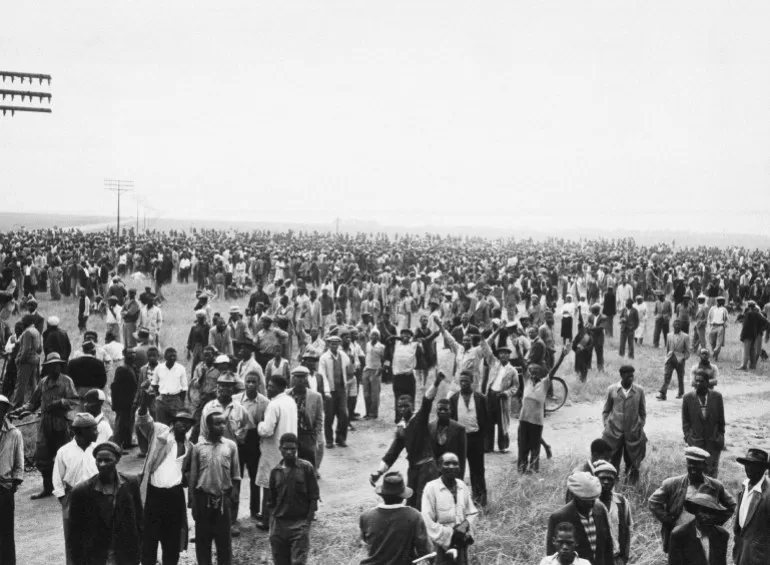On Monday, March 21, 1960, Robert Sobukwe, the 35-year-old leader of the Pan Africanist Congress (PAC), woke at 5am. His wife, Veronica, heated a kettle of water on the stove, and he washed in a tub in the kitchen of their one-bedroom house in Soweto, the largest Black township in Johannesburg.
After getting dressed, he ate his usual breakfast of eggs, bread, porridge, and tea. Sometime after 6:30am, six men from the neighbourhood arrived and, favourite pipe in hand, Sobukwe kissed Veronica goodbye.
The men walked in sombre silence as, around them, the people of Soweto hurried to get to work. “Boys, we are making history,” said Sobukwe presciently – despite all appearances to the contrary. Imagine their immense relief when, after an hour of walking, they reached Soweto’s main Orlando police station to find scores more PAC supporters already there.
The atmosphere outside the police station was jovial. “There were smiles, right hands raised in salute and cheerful shouts of ‘Izwe Lethu’ [‘the land is ours’, a PAC slogan] … PAC women from nearby houses brought coffee,” writes Benjamin Pogrund, Sobukwe’s lifelong friend and the author of How Can Man Die Better – a remarkably moving book that is both a biography of Sobukwe and a chronicle of the enduring friendship between a liberal, white reporter and a Black political leader. (“I have friends, of course, of whom I am very fond,” Sobukwe once wrote to Pogrund. “But I have long passed the stage of even thinking of you as a friend.”)
At about 8:20am, by which time the crowd had swelled to between 150 and 200 people, Sobukwe and a few others walked through the gates and knocked on the door of Captain JJ de Wet Steyn, the white officer in charge. “We have no passes and we want the police to arrest us,” said Sobukwe, referring to the documents all Black people were required to carry in “white” areas. During apartheid, past violations saw hundreds of thousands of Black South Africans arrested every year, for decades.
“I’m busy and you must wait a bit,” replied Steyn, annoyed at being interrupted by, in his words, an “adult Bantu man”. A while later, Steyn went outside to issue a warning to the crowd that had gathered on the grassy slope opposite the police station: “If there is any interference with the execution of police work, there is going to be trouble.”
While organising the nationwide anti-pass protest, Sobukwe had anticipated the possibility of a heavy-handed police response. He had even written to the Commissioner of the South African Police on March 16 to warn of his plans to launch “a sustained, disciplined, non-violent campaign against the pass laws”.
In the letter, Sobukwe asked the police to “refrain from actions that may lead to violence”. As he explained, “it is unfortunately true that many white policemen, brought up in the racist hothouse of South Africa, regard themselves as champions of white supremacy and not as law officers … I therefore appeal to you to instruct your men not to give impossible demands to my people … We will surrender ourselves to the police for arrest. If told to disperse, we will. But we cannot be expected to run helter-skelter because a trigger-happy, African-hating young white police officer has given thousands … of people three minutes within which to remove their bodies from his immediate environment.”
Outside the Orlando police station, Sobukwe and his followers waited on the lawn in the morning sun. But his worst fears were coming true elsewhere. Sometime before 11am, Pogrund came to tell his “visibly upset” friend that at least two PAC supporters had been killed by police at Bophelong, one of the townships outside the industrial town of Vanderbijlpark, about 55km (34 miles) south of Orlando.
Shortly after Pogrund left Orlando to report on the rising tensions to the south, Sobukwe and some of his supporters were finally arrested. He was driven in a police van to the clinic where Veronica worked as a nurse to collect his house keys. The cops proceeded to search his home and his office at the University of the Witwatersrand, where he taught Xhosa and Zulu, seizing liberal magazines and other “subversive” material. Sometime after 1pm, Sobukwe was booked into Marshall Square, Johannesburg’s central police station.
Unbeknownst to him, all hell was about to break loose at Sharpeville, another of Vanderbijlpark’s townships. Earlier that morning, between 5,000 and 7,000 Black South Africans who had marched to Sharpeville’s municipal offices were met with tear gas and a police baton charge. They decamped to the police station and asked to be arrested – but the commanding officer said he could not lock up so many people.
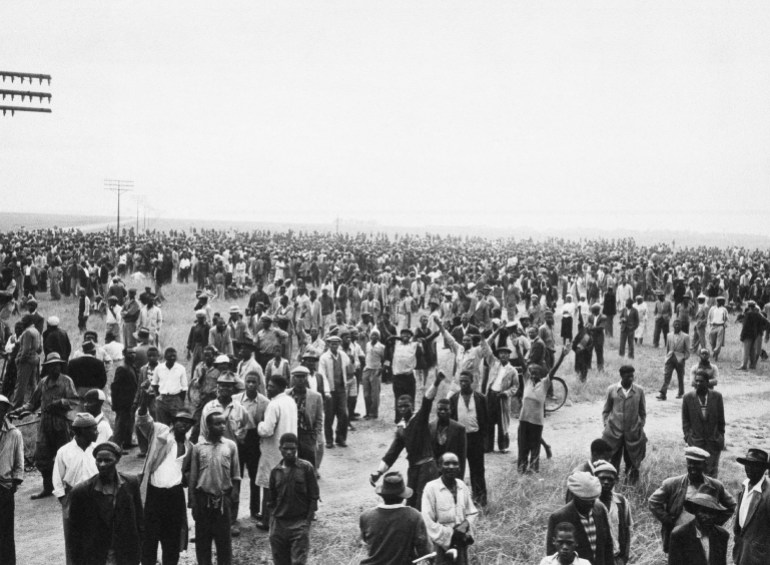
Every detail of what happened next is the subject of much dispute. The police report put the size of the crowd at 20,000, while other estimates said it was closer to 5,000. The police account stressed the hostility of the crowd, but witness accounts suggested otherwise. “A police officer said he saw a small grey car being swallowed up and thought the people in the car were being attacked,” wrote Pogrund. “But in fact, that was my car and the demonstrators were completely friendly.” Two other white journalists on the scene, Humphrey Tyler and Ian Berry, were also struck by the friendliness of the crowd.
While the protesters waited (there were rumours that a government official would come to address them) the police called in reinforcements. At about 1:30pm, after police arrested one of the protesters, the crowd pushed against the fence surrounding the station. As Pogrund writes, “one or perhaps two policemen opened fire and then there was a full volley from revolvers, rifles and Sten-guns. No order to fire was given. The shooting went on for at least forty seconds. Several policemen, including Sten-gunners, reloaded and fired again.”
Tyler, who was closer to the action than Pogrund, wrote that the crowd was “grinning, cheerful and nobody seemed to be afraid. Then the shooting started. A gun opened up toc-toc-toc and another and another … The first rush was on us, and then past. There were hundreds of women. Some of these people were laughing, probably thinking the police were firing blanks. But they were not. Bodies were falling behind them and among them. One woman was hit about ten yards from our car. Her companion, a young man, went back when she fell. He thought she had stumbled. He turned her over in the grass. Then he saw that her chest was shot away.”
In total 1,344 rounds were fired into the crowd. The police report – repeated as fact until 2023 – put the number of victims at 69 dead, including 10 children, and 180 injured. But recent research shows that at least 91 people were killed and 281 were injured. More than three-quarters of the victims were shot in the back as they tried to flee.
Three policemen were slightly injured by stones.
Sobukwe’s letter of warning had been ignored. And when news of the massacre filtered through to him in his cell in central Johannesburg, he was, according to one of his fellow inmates, “very upset. He had done his best to ensure a very orderly and peaceful campaign. How could so many die for saying they would no longer carry the symbol of slavery?”
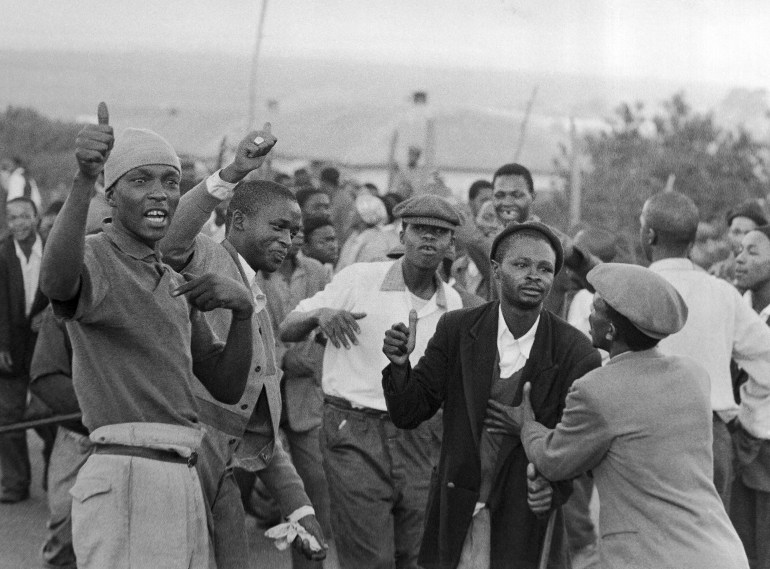
Against the odds
Born as Robert Mangaliso – meaning “it is wonderful” in isiXhosa (or Xhosa), his mother tongue – on December 5, 1924, in a Blacks-only location on the outskirts of Graaff-Reinet, a smallish sheep farming town in a forgotten corner of South Africa, Sobukwe was the youngest of seven children of Angelina, a cook and cleaner, and Hubert, a wool sorter and woodcutter. Angelina had never been to school (her thumbprint served as her signature), but Hubert had completed seven years of primary school before his mother forbade him from enrolling at high school. She thought being educated would lead him to ignore the needs of his family. “Hubert’s disappointment lived with him,” writes Pogrund, “and he made a vow: should God give him children, he would educate them all”.
The Sobukwe home had earth floors and no electricity or running water. The children slept on mattresses fashioned from wool bags but their parents saw to it that they never lacked books. It worked. At least three of the Sobukwe children qualified as teachers and one was ordained as an Anglican bishop.
Robert was always an exceptional student. After completing the free primary school education available in Graaff-Reinet, he was forced to wait two years while his parents mustered the money to send him to high school at Healdtown, the same prestigious Methodist boarding school Nelson Mandela attended. At Healdtown, he was known “for his brilliance and his command of the English language”, said classmate Dennis Siwisa.
After completing his teacher training qualification – thanks to the shortcomings of the “native” education system, the bar was set very low for Black teachers – the Healdtown staff encouraged Sobukwe not to go out and earn a living but to continue his studies. Those plans were put on ice when, aged 18, he started coughing up blood. His father wanted to take him home to die, but the school’s head teacher, George Caley, was able to wrangle a bed at a hospital specialising in tuberculosis.
Once Sobukwe had recovered, he was given a bursary by Healdtown, and Caley personally sponsored him with books and pocket money. In his final year at Healdtown, he was the school’s head boy, signing off on the role with what Caley described as a “wonderful” speech “about cooperation between whites and blacks”.
With the support of Caley, Sobukwe enrolled at Fort Hare – South Africa’s only university for Black Africans, and the alma mater of Mandela and fellow anti-apartheid icons Oliver Tambo and Govan Mbeki among many others. When he arrived at Fort Hare, aged 23, Sobukwe was not remotely interested in politics. He was, recalls Siwisa, “a happy, contented person” with a great love for literature.
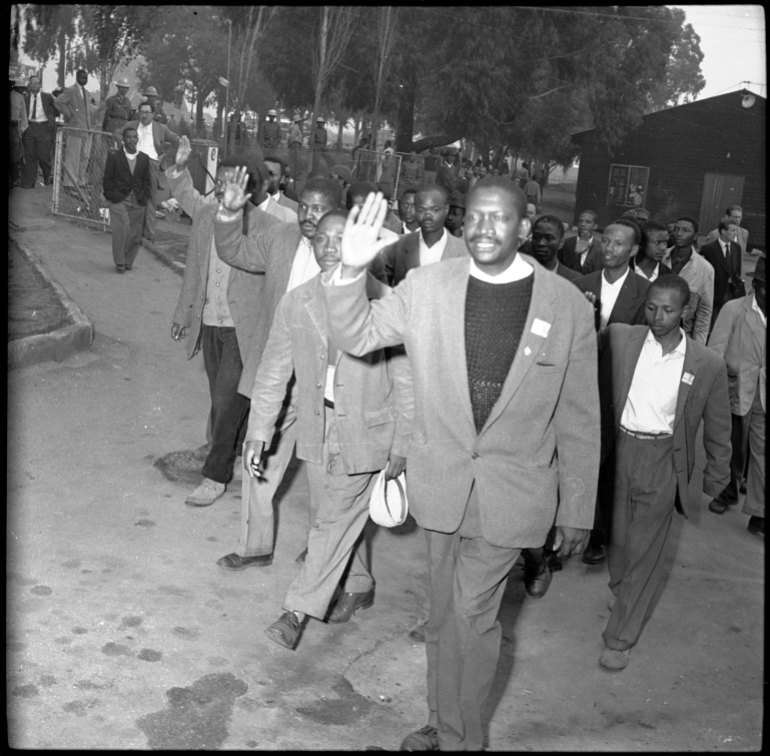
Political awakening
A second-year course on Native Administration – the many laws that governed life for Black South Africans – given by an intelligent and opinionated lecturer called Cecil Ntloko, opened Sobukwe’s eyes to the inequalities that he, and anyone else with his skin colour, faced every day. He took that course in 1948: the same year that DF Malan’s apartheid government came to power.
The following year, his last at Fort Hare, Sobukwe was elected president of the students’ representative council. He also joined the African National Congress Youth League (ANCYL) – an offshoot of the ANC founded by Mandela and others five years earlier.
Before leaving Fort Hare, he once again signed off with a speech – but his ideas had come a long way since Healdtown. In it, he implored Black South Africans to forge their own future, a future of freedom and African unity.
“People do not like to see the even tenor of their lives disturbed,” he said. “They do not like to be made to feel guilty. They do not like to be told that what they have always believed was right is wrong. And above all, they resent encroachment on what they regard as their special province. But I make no apologies. It is meant that we speak the truth before we die.”
The speech, whose text has survived, was a spellbinding contrast with the much better-known Mandela’s public oration, which for the most part was relatively boring. “It was too hot!” remembered Ntloko, of Sobukwe’s Healdtown speech.
“I wish to make it clear again that we are anti-nobody,” Sobukwe said midway through it. “We are pro-Africa. We breathe, we live, we dream Africa; because Africa and humanity are inseparable … On the liberation of the African depends the whole world.”
When news of the speech, and its supposedly anti-white message reached Caley at Healdtown, it came as a “dreadful shock”. The plan had always been for Sobukwe to return to Healdtown as a teacher – but now he would have to look for work elsewhere.
Africanists and Charterists
After two relatively uneventful years of teaching (he did almost get fired for organising political meetings in his spare time) at a secondary school in the far-off farming town of Standerton, Sobukwe was offered a job teaching Zulu and Xhosa at the liberal, white University of the Witwatersrand in Johannesburg. While in Standerton, Sobukwe’s ties with the ANC had weakened somewhat, but in Johannesburg – the epicentre of the struggle – he was thrown back into the daily affairs of the party.
And he did not agree with everything he saw or heard. Sobukwe soon fell in with an informal grouping within the ANC who called themselves “Africanists”. The Africanists were fiercely anti-communist and they were opposed to the ANC working with other colour groups, as they felt that the struggle should be “for Africans, by Africans”. When, in 1955, the ANC teamed up with congress movements representing other race groups to sign the Freedom Charter – which declared “that South Africa belongs to all who live in it, black and white” – it created a rift between the Africanists and the Charterists. This rift would culminate in Sobukwe and about 100 other Africanists splitting from the ANC in 1958, and forming the PAC a year later.
In his autobiography, Mandela expressed disappointment at the behaviour of his “old friend” Sobukwe. “I found the views and behaviour of the PAC immature … While I sympathised with the views of the Africanists and once shared many of them, I believed that the freedom struggle required one to make compromises.”
Sobukwe was unanimously elected as leader of the new party. While some in the ANC had accused him of being “anti-white” he cleared this up in a rousing opening address at the Orlando Communal Hall on April 4, 1959: “We aim, politically, at government of the Africans by the Africans, for the Africans, with everybody who owes his only loyalty to Africa and who is prepared to accept the democratic rule of an African majority being regarded as an African. Here is a tree rooted in African soil, nourished with waters from the rivers of Africa. Come and sit under its shade and become, with us, the leaves of the same branch and the branches of the same tree.”
Later in the speech, he reiterated this point even more clearly: “There is only one race to which we all belong, and that is the human race.”
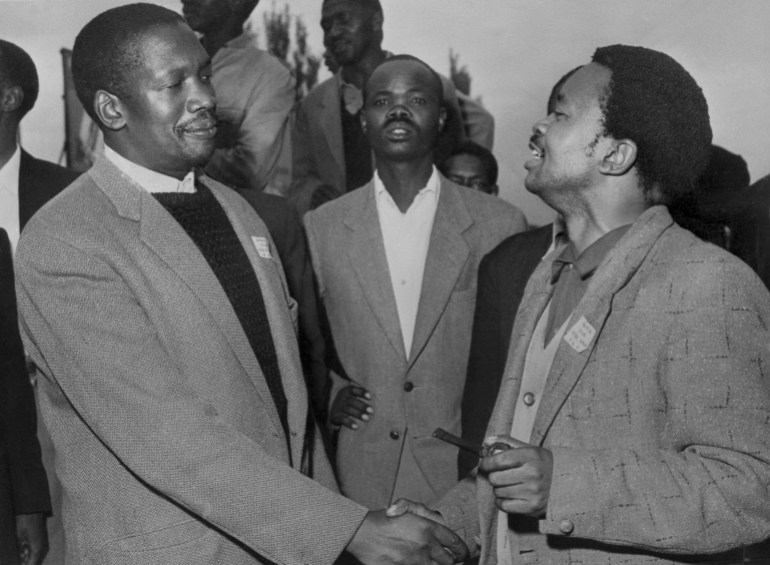
Countdown to Sharpeville
Despite these lofty ideals, the PAC was locked in a – sometimes petty – tussle with the ANC to win the hearts and minds of Black South Africans. Sobukwe embarked on a nationwide tour to drum up support for his new party. And when the ANC announced its intention to stage an anti-pass campaign on March 31, 1960, Sobukwe resolved to get a jump on them. He had initially planned to launch the PAC’s campaign on March 7, but issues with printing flyers forced him to postpone by two weeks.
Many, including some in the PAC, thought Sobukwe was being overly hasty and few outside the organisation could take seriously the PAC’s stated aim to achieve “freedom and independence” for Black people by 1963. As Mandela put it, “It is always dangerous for an organisation to make promises it cannot keep.”
But no one – bar the apartheid government – could blame Sobukwe or the PAC for the massacre that occurred at Sharpeville on March 21.
As Mandela put it: “In just one day, they had moved to the front lines of the struggle and Robert Sobukwe was being hailed inside and outside the country as the saviour of the liberation movement. We in the ANC had to make rapid adjustments to this new situation, and we did so.”
On March 26, Albert Luthuli, the ageing ANC chief, Mandela and others publicly burned their passes. Two days later, heeding the call of the ANC, hundreds of thousands of Black South Africans around the country stayed away from work in protest against the killings. As historian Hermann Giliomee writes, “Many whites were terrified; the Stock Exchange plummeted, followed by a massive capital outflow. With worldwide condemnation of the killings and of the harshness of apartheid policy, international isolation seemed a real possibility.”
The government responded with an iron fist, arresting more than 18,000 people and banning the ANC and the PAC. On April 9, in his first public appearance since Sharpeville, Prime Minister Hendrik Verwoerd was shot in the face by an English-speaking trout farmer. While Verwoerd was recovering from the assassination attempt, acting Prime Minister Paul Sauer called for major policy changes, stating “the old book of South African history was closed … at Sharpeville”.
For the first time in years, the liberation movement had a glimmer of hope. But this would be short-lived. When Verwoerd got back to work – he made a remarkably quick recovery – he doubled down, announcing a referendum in which he asked (white) South Africans whether the country, which was still a British dominion, should become an independent republic. Verwoerd just won narrowly – but when South Africa was declared a republic on May 31, 1961, the final handbrake to his dream of Grand Apartheid was removed.
A man apart
On May 4, Sobukwe and 17 other PAC leaders were found guilty of “inciting people to commit an offence” and Sobukwe was sentenced to three years in prison, which he served in two jails near Johannesburg. As the end of his sentence neared, the apartheid government debated what to do with him.
Justice Minister BJ Vorster came up with a uniquely cruel solution: he rushed through parliament an amendment to the Suppression of Communism Act (SCA) which stated: “Anyone convicted under security laws could be imprisoned after his sentence had ended if the Minister of Justice considered he was likely, if released, to further the achievements of any of the objects of communism.”
Sobukwe, of course, was fiercely anti-communist. But the SCA absurdly defined communism as “any doctrine or scheme … which aims at bringing about any political, industrial, social or economic change”.
No sooner had the amendment, which became known as the Sobukwe clause, been passed, than Sobukwe was whisked off to Robben Island – the site of the notorious political prison where Mandela and many others would later be imprisoned – and installed in a small house removed from the main prison.
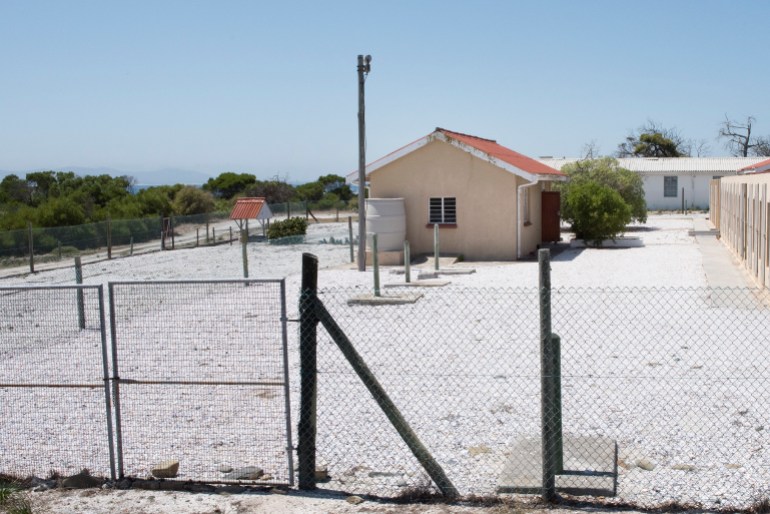
The Sobukwe clause was only ever used against one person – Robert Sobukwe. And he was also the only prisoner on Robben Island who was forbidden any contact with other inmates.
In 1969, with his health failing, Sobukwe was released from Robben Island and allowed to live with his family in Kimberley – a town he “did not know” – under house arrest. There he was subject to banning orders which prohibited him from engaging in any political activities. He did his best to get around these restrictions, regularly meeting other political figures including the much younger Steve Biko, whose Black Consciousness movement was in many ways inspired by Sobukwe’s teachings.
After being refused proper healthcare until it was too late, Sobukwe died of lung cancer on February 27, 1978, and was buried in his birthplace, Graaff-Reinet, at a chaotic funeral led by Archbishop Desmond Tutu.
United States Senator Dick Clark of Iowa, who met Sobukwe in 1976, said after his death: “He was a very gentle man. More than any other person I met in South Africa, he represented what I had read about: that people could still be rational in the demand for change, not bitter. I could hardly understand it – the lack of bitterness.”
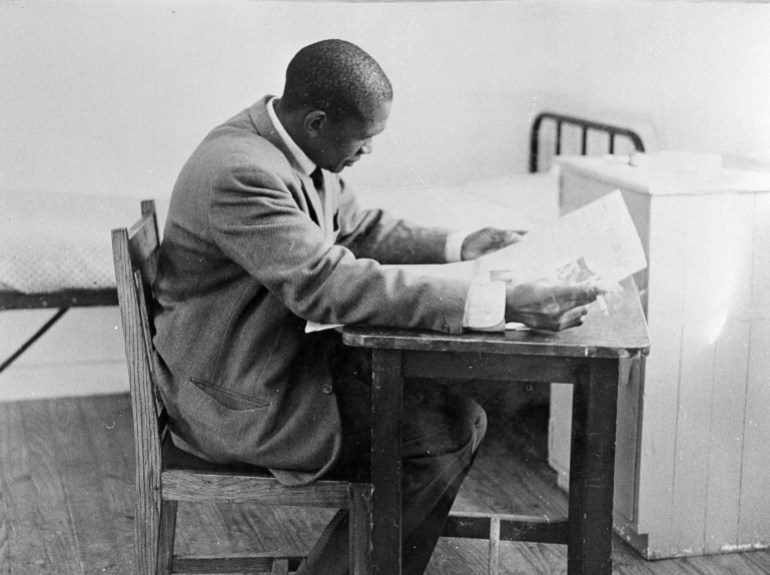
‘Power of belief in humanity’
Writing in 2015, Pogrund noted: “South Africa has not been kind to Robert Sobukwe. The magnitude of his deeds and beliefs is largely ignored. The African National Congress in government has done much to airbrush him out of the freedom struggle. He is seldom referred to.”
Yet on his 100th birth anniversary, South Africa still grapples with its struggle to realise many of the ideals that Sobukwe espoused.
As Anthony Lewis wrote in his New York Times obituary of Sobukwe: “A few times in his life a newspaper reporter meets a political figure and senses authentic greatness: a magnetic external presence combined with a sense of inner serenity. That happened to me on June 9, 1975, in the South African mining town of Kimberley. I met Robert Sobukwe.
“He was despised and rejected by those who hold power in his country. He lived in enforced obscurity, unable to travel, his countrymen forbidden to read his words. But there was a power in him that shone through all the petty cruelties of official suppression. It was the power of belief in humanity, in nonviolent change toward justice, and those who oppressed him should pray that it will survive his death this week.”
